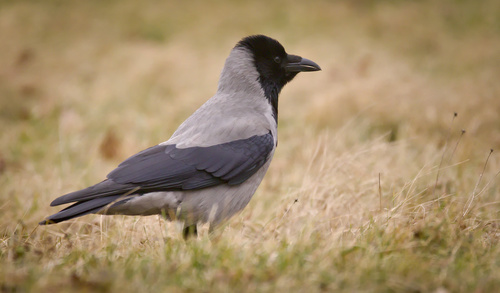
Hooded Crow
The Hooded Crow (Corvus cornix) is a widespread bird species known for its distinctive appearance and adaptability. It plays a significant ecological role as both a scavenger and a predator, contributing to nutrient cycling and controlling populations of smaller animals. While not holding major cultural significance in many areas, its intelligence and bold behavior have led to its presence in folklore and local traditions in some regions. It is closely related to the Carrion Crow, and the two were once considered the same species.
48-52 cm
Length
98-104 cm
Wingspan
Least Concern
Conservation Status
Distribution
The Hooded Crow is found across Northern, Eastern, and Southeastern Europe, as well as parts of the Middle East. Its range overlaps with the Carrion Crow in a narrow hybrid zone. It is largely resident, but northern populations may migrate south in winter.
Lifespan
The average lifespan in the wild is 4-7 years, but individuals can live much longer. One recorded individual lived for over 16 years.
Hooded Crow's Habitat
Habitat Types
Open woodlands, Farmlands, Moorlands, Coastal cliffs, Urban parks, Riverbanks
Climate Zones
Temperate, Boreal, Mediterranean
Adaptations
The Hooded Crow is highly adaptable, thriving in a variety of habitats. Its strong bill allows it to exploit a wide range of food sources. It is also known for its intelligence and problem-solving abilities, which aid in survival.
Variations
Several subspecies have been recognized, differing slightly in plumage and size. These include *C. c. cornix*, *C. c. sharpii*, *C. c. pallescens*, and *C. c. capellanus*. The taxonomy is still debated in some areas.
Appearance
Breeding Plumage
Plumage is generally consistent year-round.
Seasonal Feather Changes
No significant seasonal variation.
Sex Based Plumage Differences
Males and females have similar plumage.
Notable Features
Black head, throat, wings, and tail., Grey torso and belly., Strong, black bill., Black legs.
Diet and Feeding
Primary Foods
Insects, Seeds, Grains, Carrion, Small vertebrates, Eggs, Fruit, Human refuse
Foraging Behavior
Hooded Crows are opportunistic omnivores, foraging on the ground, in trees, and along shorelines. They often use tools, such as sticks, to extract insects from crevices. They are also known to drop hard-shelled prey from heights to break them open.
Specializations
Their strong bill allows them to handle a wide variety of food items. Their intelligence and adaptability allow them to exploit diverse food sources and changing environments.
Seasonal Diet Variations
Diet varies seasonally depending on food availability. In winter, they may rely more on seeds, grains, and carrion, while in spring and summer, insects and other invertebrates become more important.
Behavior
Social Structure
Hooded Crows are often seen in pairs or small family groups. During the non-breeding season, they may form larger flocks, especially at roosting sites.
Communication
Harsh 'kaah' calls., Rattling calls., Clicking sounds., Body postures such as bowing and wing-flicking.
Migration
While many populations are resident, some northern populations migrate south for the winter. The extent of migration varies depending on the severity of the winter.
Territorial or Group Behaviors
Hooded Crows are territorial during the breeding season, defending their nesting area from intruders. Outside of the breeding season, they may form communal roosts.
Conservation
Threats
Habitat loss due to agriculture and urbanization., Persecution by humans (in some areas, due to perceived damage to crops or livestock)., Pesticide use (indirectly, through the food chain).
Protection Programs
General wildlife protection laws in many countries., Monitoring of populations.
Local National Laws
Protected under various national and international wildlife laws, although specific regulations vary by country.
Population Trend
Stable
Population Estimates
The global population is estimated to be 14,000,000-34,000,000 individuals.
Interesting Facts
Hooded Crows are known for their intelligence.
They are capable of problem-solving, tool use, and recognizing individual human faces.
They hybridize with Carrion Crows where their ranges overlap.
This hybridization zone provides valuable insights into speciation and evolution.
They can mimic sounds.
Although not as proficient as some other corvids, they have been known to imitate other bird calls and even human speech.
They cache food.
Hooded Crows hide food items for later retrieval, demonstrating impressive spatial memory.
Faqs about Hooded Crow
Are Hooded Crows and Carrion Crows the same species?
They were once considered subspecies, but are now generally recognized as separate species. They can, however, interbreed where their ranges overlap.
What do Hooded Crows eat?
They are omnivores and have a very varied diet, including insects, seeds, carrion, small animals, eggs, and human refuse.
Are Hooded Crows aggressive?
They can be aggressive in defending their nests and territories, but are generally not a threat to humans.
Where do Hooded Crows build their nests?
They build nests in a variety of places like trees, cliffs, and even sometimes on buildings.
Copyright @ Nature Style Limited. All Rights Reserved.
 English
English